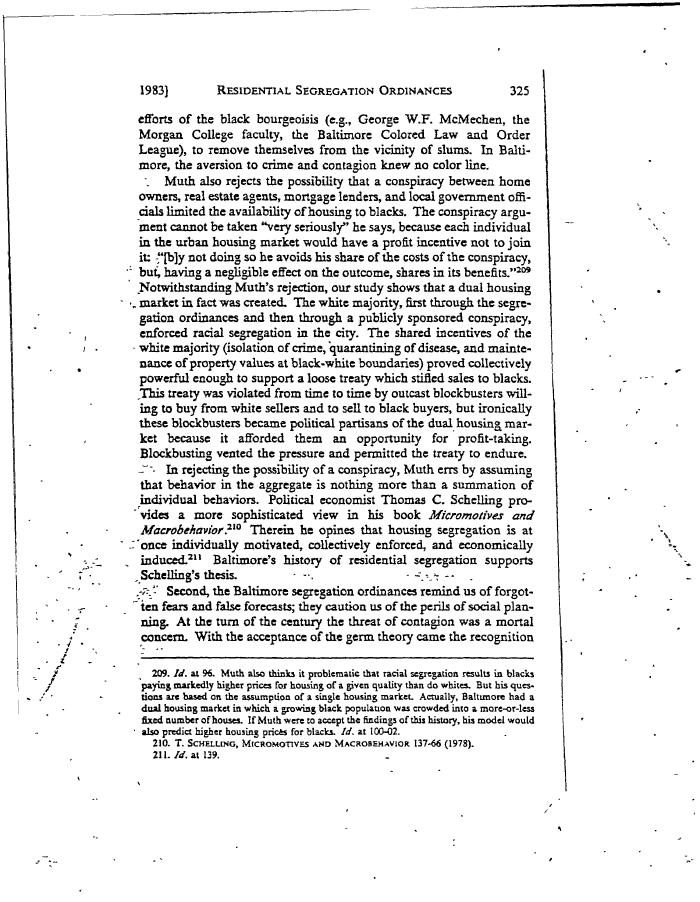 |
||||
|
Garrett Power, Apartheid Baltimore Style: The Residential Segregation Ordinances of 1910-1913, Maryland Law Review, 42 (1983) , Image No: 38 Enlarge and print image (72K) << PREVIOUS NEXT >> |
 |
||||
|
Garrett Power, Apartheid Baltimore Style: The Residential Segregation Ordinances of 1910-1913, Maryland Law Review, 42 (1983) , Image No: 38 Enlarge and print image (72K) << PREVIOUS NEXT >> |
| 1983] RESIDENTIAL SEGREGATION ORDINANCES 325 efforts of the black bourgeoisis (e.g., George W.F. McMechen, the Morgan College faculty, the Baltimore Colored Law and Order League), to remove themselves from the vicinity of slums. In Balti- more, the aversion to crime and contagion knew no color line. Muth also rejects the possibility that a conspiracy between home owners, real estate agents, mortgage lenders, and local government offi- cials limited the availability of housing to blacks. The conspiracy argu- ment cannot be taken "very seriously" he says, because each individual in the urban housing market would have a profit incentive not to join it "by not doing so he avoids his share of the costs of the conspiracy, but, having a negligible effect on the outcome, shares in its benefits.209 .Notwithstanding Muth's rejection, our study shows that a dual housing market in fact was created. The white majority, first through the segre- gation ordinances and then through a publicly sponsored conspiracy, enforced racial segregation in the city. The shared incentives of the white majority (isolation of crime, quarantining of disease, and mainte- nance of property values at black-white boundaries) proved collectively powerful enough to support a loose treaty which stifled sales to blacks. This treaty was violated from time to time by outcast blockbusters will- ing to buy from white sellers and to sell to black buyers, but ironically these blockbusters became political partisans of the dual housing mar- ket because it afforded them an opportunity for profit-taking. Blockbusting vented the pressure and permitted the treaty to endure. In rejecting the possibility of a conspiracy, Muth errs by assuming that behavior in the aggregate is nothing more than a summation of individual behaviors. Political economist Thomas C. Schelling pro- vides a more sophisticated view in his book Micromotives and Macrobehavior?210 Therein he opines that housing segregation is at once individually motivated, collectively enforced, and economically induced.211 Baltimore's history of residential segregation supports ,Schelling's thesis. Second, the Baltimore segregation ordinances remind us of forgot- ten fears and false forecasts; they caution us of the perils of social plan- ning. At the turn of the century the threat of contagion was a mortal concern. With the acceptance of the germ theory came the recognition 209. Id. at 96. Muth also thinks it problematic that racial segregation results in blacks paying markedly higher prices for housing of a given quality than do whites. But his ques- tions are based on the assumption of a single housing market Actually, Baltimore had a dual housing market in which a growing black population was crowded into a more-or-less fixed number of houses. If Muth were to accept the findings of this history, his model would also predict higher housing prices for blacks. Id. at 100-02. 210. T. SCHELLING, MtCROMOTTVES AND MACROBEHAV1OR 137-66 (1978). 211. Id. at 139. |